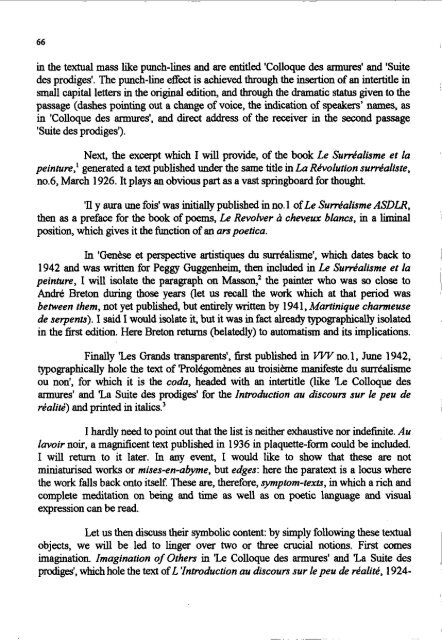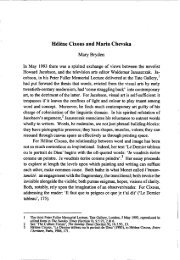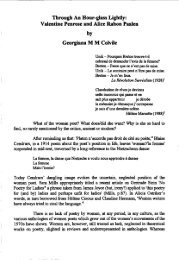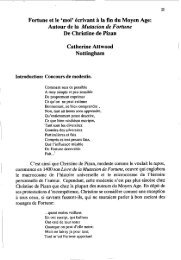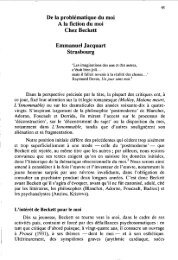The Poetics of Bricolage: André Breton's Theoretical Fables by ...
The Poetics of Bricolage: André Breton's Theoretical Fables by ...
The Poetics of Bricolage: André Breton's Theoretical Fables by ...
Create successful ePaper yourself
Turn your PDF publications into a flip-book with our unique Google optimized e-Paper software.
66<br />
in the textual mass like punch-lines and are entitled 'Colloque des armures' and 'Suite<br />
des prodiges'. <strong>The</strong> punch-line effect is achieved through the insertion <strong>of</strong> an intertitle in<br />
small capital letters in the original edition, and through the drmatic status given to the<br />
passage (dashes pointing out a change <strong>of</strong> voice, the indication <strong>of</strong> speakers' names, as<br />
in 'Colloque des armures', and direct address <strong>of</strong> the receiver in the second passage<br />
'Suite des prodiges').<br />
Next, the excerpt which I will provide, <strong>of</strong> the book Le Surréalisme et la<br />
peinture,' generated a text published under the same title in La Révolution surréaliste,<br />
n0.6, March 1926. It plays an obvious part as a vast springboard for thought.<br />
'Ii y aura une fois' was initially published in no. 1 <strong>of</strong> Le Sudalisme ASDLR,<br />
then as a preface for the book <strong>of</strong> poems, Le Revolver à cheveux blancs, in a liminal<br />
position, which gives it the function <strong>of</strong> an ars poetica.<br />
In 'Genèse et perspective artisîiques du surréalisme', which dates back to<br />
1942 and was written for Peggy Guggenheim, then included in Le Surréalisme et la<br />
peinture, I will isolate the paragraph on Masson? the painter who was so close to<br />
<strong>André</strong> Breton during those years (let us recall the work which at that period was<br />
between them, not yet published, but entirely written <strong>by</strong> 1941, Martinique charmeuse<br />
de serpents). I said I would isolate it, but it was in fact already typographically isolated<br />
in the first edition. Here Breton returns (belatedly) to automatism and its implications.<br />
Finally 'Les Grands îransparents', ñrst published in VW no. 1, June 1942,<br />
typographically hole the text <strong>of</strong> 'Prolégomènes au troisième manifeste du surréalisme<br />
ou non', for which it is the coda, headed with an intertitie (like 'Le Colloque des<br />
armures' and 'La Suite des prodiges' for the Introduction au discours sur le peu de<br />
réalité) and printed in italics.'<br />
I hardly need to point out that the list is neither exhaudve nor indeñnite. Au<br />
lavoir noir, a magnificent text published in 1936 in plaquette-form could be included.<br />
I will retuni to it later. in any event, I would like to show that these are not<br />
miniaturised works or mises-en-a<strong>by</strong>me, but edges: here the paratext is a locus where<br />
the work falls back onto itself. <strong>The</strong>se are, therefore, symptom-texts, in which a rich and<br />
complete meditation on being and time as well as on poetic language and visual<br />
expression can be read.<br />
Let us then discuss their symbolic content: <strong>by</strong> simply following these textual<br />
objects, we will be led to linger over two or three crucial notions. First comes<br />
imagination. Imagination <strong>of</strong> Others in 'Le Colloque des armures' and 'La Suite des<br />
prodiges', which hole the text <strong>of</strong> L 'Introduction au discours sur le peu de réalité, 1924-


